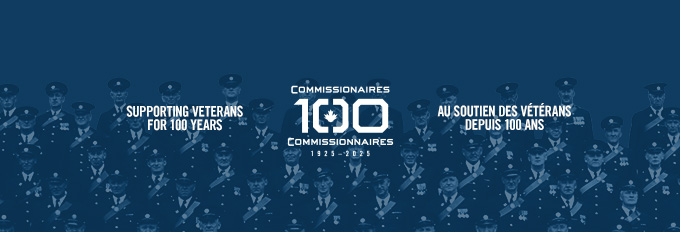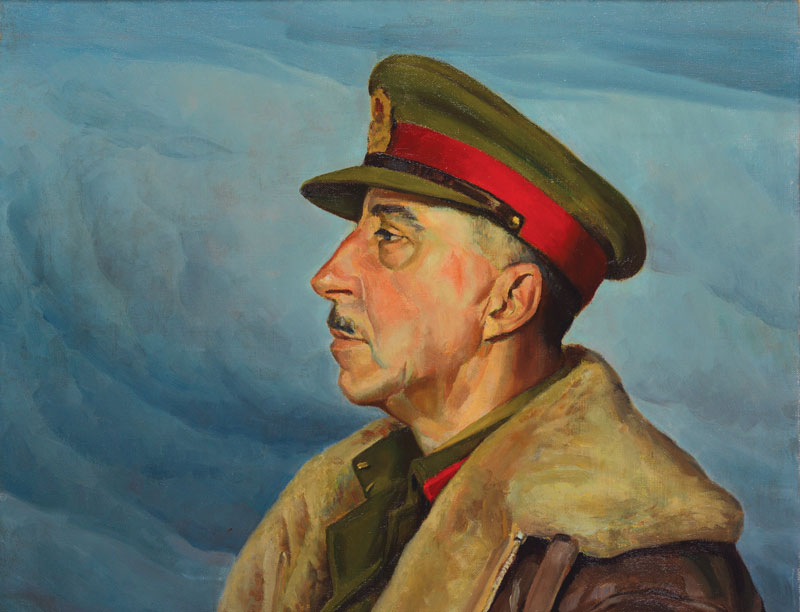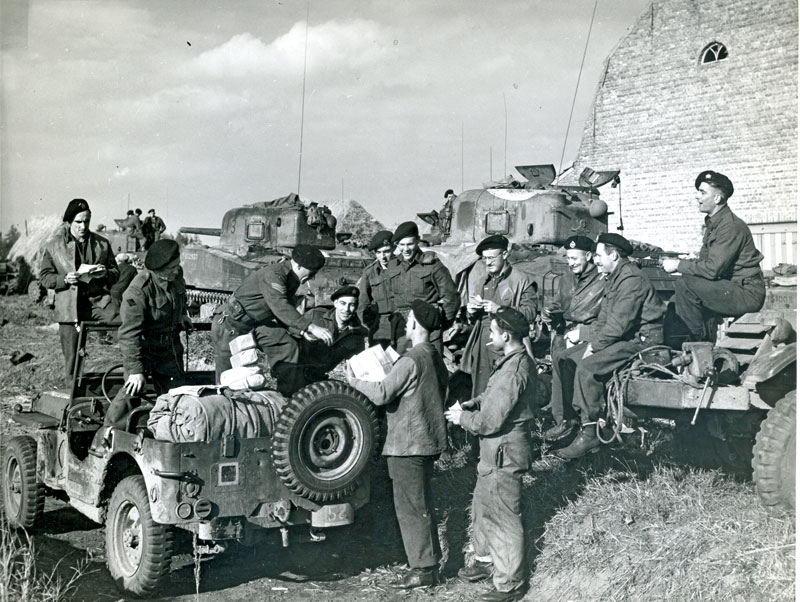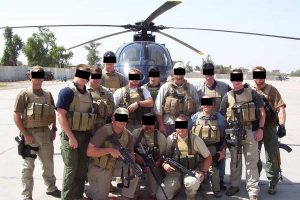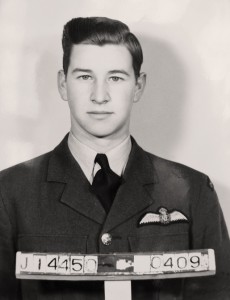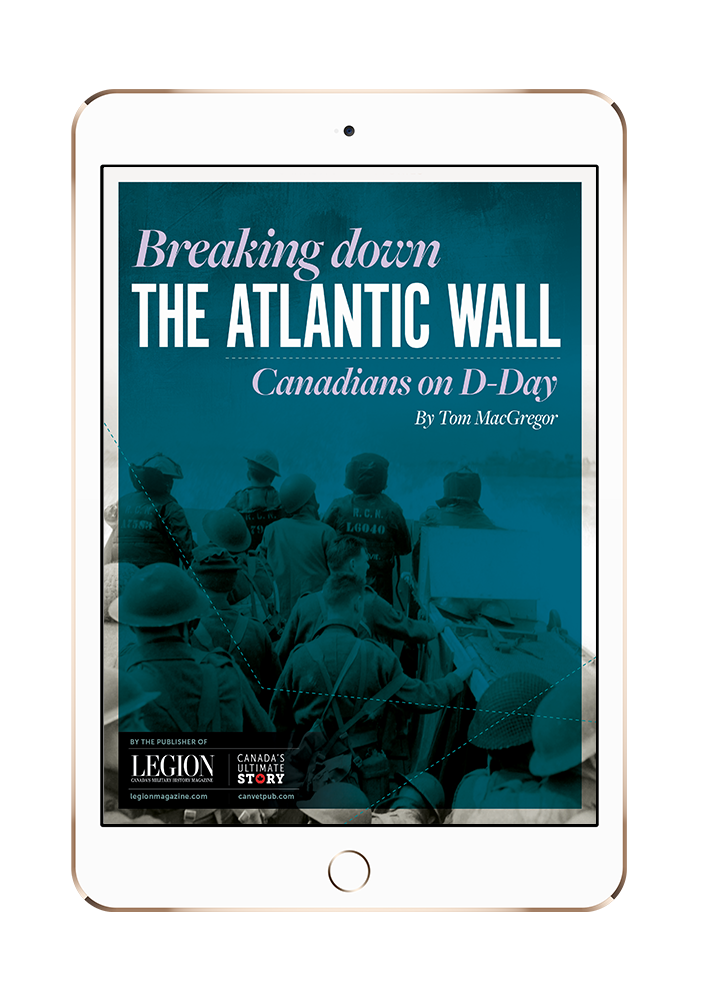Jan. 16, 1945, Field Marshal Bernard Montgomery summoned General Harry Crerar to his tactical headquarters. In his usual terse manner, Montgomery told Crerar the time had come for the Allies to engage the Germans in “a potentially decisive…operation.” That operation was the Rhineland Campaign, which aimed to capture a narrow wedge of ground south of the Rhine River that ran to the east of the Netherlands’ Groesbeek to Wesel—a distance of about 65 kilometres.
This would be the first part of Germany targeted by the Allies. First Canadian Army’s Crerar was to lead the British-Canadian advance southeast from Groesbeek along the Rhine’s southern shoreline to link up with a U.S. Ninth Army drive northeast from the Maas River to Wesel. What was anticipated to be a large number of German divisions concentrated to hold this ground would be crushed between the two closing Allied armies.

In February 1945, Lieutenant-General Guy Simonds and Field Marshal Bernard Montgomery meet with General Harry Crerar. [LAC/4002428]
At the same time, this region of the Rhineland would provide British 21st Army Group with a launching point to cross the Rhine. Once on the opposite bank, the British would push into Germany’s industrial Ruhr valley, while the Canadians would move westward into the Netherlands to begin liberating it.
Crerar wouldn’t just have First Canadian Army’s II Canadian Corps and I British Corps under his command. Added in was Lieutenant-General Brian Horrocks’ XXX Corps from British Second Army. This was going to be a juggernaut smashing into the Germans on a very narrow front.
Montgomery hadn’t given the task to Crerar willingly. It fell to the Canadian because of the alignment of the British forces. The Canadians were on the 21st Army Group’s left flank, so—as the man on the ground—Crerar had to command.
Montgomery’s relationship with Crerar had been fraught since the Canadians had come under Montgomery’s command in southern England. Montgomery also considered Crerar incompetent. For these reasons, following the D-Day landings in Normandy, Montgomery had deliberately prevented Crerar from bringing his army headquarters across the English Channel to take direct command. Instead, II Canadian Corps and I British Corps were brought under Second British Army’s Lieutenant-General Miles Dempsey. It was a move that suited both corps’ commanders, Canadian Lieutenant-General Guy Simonds and British Lieutenant-General John Crocker. Each had their own issues with Crerar’s competency and personality.
At 55, Crerar was a Great War veteran who had ascended to army command via a series of staff positions. He had put in a brief stint leading I Canadian Corps in Italy, but this only further soured his relationship with then-Eighth Army commander Montgomery. The corps command had been a necessary step for Crerar to become Canada’s overseas army commander.
Horrocks soon held the Canadian in high regard. He considered Crerar “much underrated, largely because he was the exact opposite to Montgomery.”
Crerar was methodical, hard-working, and detail oriented. He favoured multi-page, complex operational directives, the very kind of products shunned by Montgomery. In his manner and dress, he was formal and a stickler for regulations. Montgomery, meanwhile, favoured informal dress and had a habit of wearing a black beret, even though he had never served in an armoured regiment.
While Crerar and Montgomery were polar opposites, the British-born Simonds tended to mimic Montgomery, including wearing the same headwear. Montgomery had long considered Simonds a protege and respected his abilities as a soldier and commander. This meant he was happy that Simonds was effectively in command of the Canadians in Normandy. Simonds, Monty wrote, was “far better than Crerar” and “the equal of any British Corps Commander.”
Crerar, he noted on the other hand, was “very…stodgy, and…very definitely not a commander.”
For his part, Crerar seethed that Montgomery’s clear attempts to keep him away from his army reflected the “Englishman’s traditional belief in the superiority of the Englishman.” No “Canadian…is ever rated as high as the equivalent Britisher.”

Infantrymen of The North Shore (New Brunswick) Regiment board an Alligator amphibious vehicle at the start of Crerar-led Operation Veritable on Feb. 8, 1945. [Colin McDougall/DND/LAC/PA-190818]
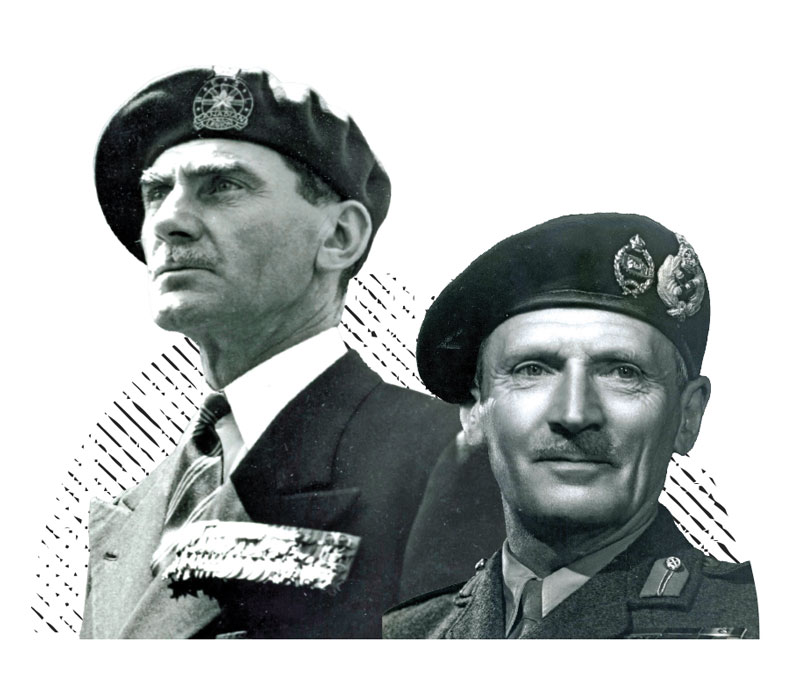
Canadian Guy Simonds (opposite left) tended to mimic British commander Bernard Montgomery while Crerar was their polar opposite.[LM archive (2)]
Montgomery, however, couldn’t keep Crerar isolated for the war’s duration. Accordingly, on July 23, 1944, Crerar established an army headquarters in Normandy. Due to the narrow battlefield, however, Simonds continued directing II Corps operations in the drive to Falaise and in ultimately closing the gap that consigned thousands of Germans to either death or capture.
Thereafter, the Canadians advanced up the French coast under Crerar. Save for a short pursuit of German divisions to the Seine, what was to be known as the Channel ports Campaign required little direction from army headquarters. Instead, it consisted largely of sieges by individual divisions of port cities—such as Le Havre, Boulogne and Calais.
Crerar’s major battlefield debut should have come during the Sept. 13-Nov. 6, 1944, Scheldt Campaign, which aimed to open the huge Belgian port of Antwerp to Allied shipping. On Sept. 25, just as that operation was developing into a major fight, Crerar was diagnosed with dysentery and a possible blood disorder and evacuated to England. He wouldn’t recover until Antwerp was open and the guns had fallen silent.
First Canadian Army spent a harsh winter holding a line from Walcheren Island in the Netherlands along the south bank of the Maas River (as the Dutch called the Rhine there) east to near Groesbeek by the German border. Fighting was sporadic and isolated, but still costly at times for both sides. Meanwhile, on Dec. 16, Crerar had started planning Operation Veritable—the offensive into Germany’s Rhineland—at Montgomery’s direction. That initiative, however, fizzled immediately: a German offensive smashed into the Ardennes region the very same day and had the thin American line there reeling. The ensuing Battle of the Bulge became the focus of all Allied activity at the time and raged through to Jan. 16, 1945.
The original plan for Veritable was to have been launched sometime in January when the battlefield and approaches to it would have still been frozen, enabling tanks and vehicles to move relatively easily across the hardened ground. The German offensive had thwarted that, and Montgomery consequently selected a Feb. 8 start. After the worst winter weather Europe had experienced in 50 years, lingering rains and melting snow were expected to render the battlefield a muddy quagmire.
But, from General Dwight D. Eisenhower, the supreme commander of the Allied forces in Europe, down the ranks, the Allies were in a hurry to seize the Rhineland and prepare for the advance into Germany’s heartland.
At Canadian army headquarters, Crerar and his staff faced an unprecedented logistical challenge. With three corps under his command, Crerar had at his disposal 449,865 soldiers as opposed to the army’s normal compliment of about 150,000. Montgomery had bolstered XXX Corps to five infantry divisions, two armoured divisions and four armoured brigades. Second British Army, meanwhile, was stripped down to four divisions and three independent brigades. Everything else went to Crerar.
Now, Crerar’s penchant for detailed planning proved invaluable. The army’s requirements were vast and needed to be identified and precisely provided. Ammunition of 350 different varieties ranging from 105-millimetre shells to .303-calibre rifle cartridges had to be assembled. Awed, Crerar noted that if all this ammo “were stacked side by side and five feet high, it would line a road 30 miles.”
The numbers were staggering: 2.3 million rations, 5 million litres of petrol for just the first four days, 13,000 kilometres of communication cables, 85,000 smoke generators, some 800,000 maps and 500,000 aerial photos. More than 35,000 vehicles soon jockeyed toward position with 1,600 military police trying to prevent gridlock. And in addition to maintaining roads suffering from increasing wear and tear, engineers built new ones crudely surfaced by laying logs side by side. This required 18,000 logs and, while providing bumpy going, prevented vehicles from miring in mud.
The sheer might under Crerar’s command was necessary for success. With no chance of achieving surprise, the army would launch a frontal assault against well-prepared and strengthened positions—initially the vaunted Siegfried Line.
One after another, Germany’s best remaining divisions in the west were committed—and slaughtered.

Members of The Royal Winnipeg Rifles leave Niel, Belgium, on Feb. 9, 1945 [Wikimedia/Imperial War Museums]
Horrocks and his ballooned XXX Corps were to open Veritable with only 3rd Canadian Infantry Division advancing on its left flank. As the launch date approached, Horrocks fought an unexplainable illness that made him irritable. Horrocks was impressed that Crerar patiently excused his bad-tempered behaviour.
In fact, Horrocks soon held the Canadian in high regard. He considered Crerar “much underrated, largely because he was the exact opposite to Montgomery. He hated publicity, but was full of common sense and always prepared to listen to the views of his subordinate commanders.”
Crerar also showed an ability for grasping and considering the complexities of the modern battlefield. He carefully monitored the logistical expansion. Endless hours were spent establishing, Crerar wrote, that “the technique of the fire preparation for the assault was worked out in order to ensure the closest possible integration of movement with overwhelming fire both from artillery and the air…I gave instructions to my senior officers that once the operation began, commanders…must be seized with…keeping the initiative, maintaining the momentum of the attack…through the enemy without cessation.”
Ground objectives were to be seen as no more than a means to an end. Before the attack, every soldier was to be briefed so he understood his tasks and their importance to achieving victory.
Crerar repeatedly made it clear that while winning the Rhineland was important, the greater purpose of Veritable “was to destroy the enemy.” Defeating the Germans was insufficient, Crerar and his headquarters staff reiterated. They must be killed or taken prisoner. Therein lay true victory, because this would leave the enemy so weakened that capturing the rest of Germany should go quickly.
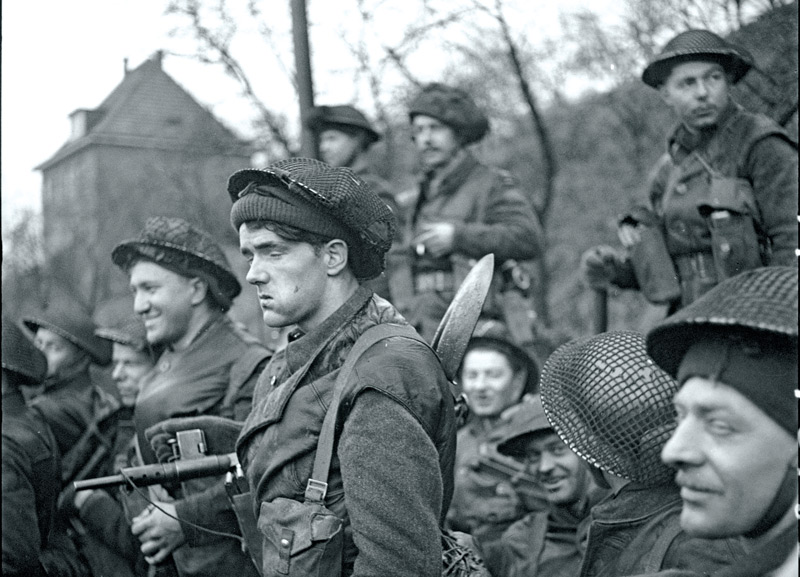
A column of Churchill tanks and other vehicles advance at the start of Operation Veritable the previous day. [Colin McDougall/DND/LAC/PA-145769]
On Feb. 8 at 10:30 a.m., following a prolonged artillery and aerial bombardment that had pounded German positions throughout the Rhineland, Crerar unleashed the massive juggernaut stationed on the Dutch-German border. Fifty thousand soldiers, supported by 500 tanks and 500 of the specialized tanks of British 79th Armoured Division, led. As the Canadians and British slammed into the defending Germans, the battle descended into nightmare with heavy casualties on both sides.
There was to be no surcease, no pause. As one infantry battalion ran out of steam or was shredded by enemy fire, another leapfrogged it. On the left, 3rd Canadian Infantry Division—already nicknamed “the water rats” for its role fighting in the flooded terrain of the Scheldt—used amphibious Buffaloes and Weasels to move through a wide swath of submerged land after the Germans had blown dikes along the Rhine River. After two days of hell, however, the Siegfried Line—built over years to defend the Rhineland—was broken.
The Germans fell back into a series of prepared defensive lines that had to each be taken in turn. As their casualties mounted, the overall intent of the offensive was achieved. More German divisions were fed in because Hitler refused to cede any of his country’s ground. One after another, Germany’s best remaining divisions in the west were committed—and slaughtered.
When Veritable ran out of steam on Feb. 22 in front of a road running north to south from Calcar to Goch, Germany, Crerar allowed a brief pause. Four days later, he launched Operation Blockbuster, led mostly by the Canadians. In front of the dense Hochwald Forest, it seemed the advance might falter—the woods bristling with Germans holding entrenchments with fanatical determination. But Crerar threw more Canadian battalions into the narrow Hochwald gap, and they fought through and took Xanten. Nearby, they met up with U.S. Ninth Army and ended the campaign.
The Allies paid a terrible cost in the campaign—15,634 casualties, 5,304 of which were Canadian. The German decision to defend the Rhineland proved a disastrous folly. First Canadian Army took 22,239 prisoners with another 22,000 killed or suffering long-term wounds. Including those taken and killed by the Americans, total German losses were tallied at 90,000.
Thereafter, First Canadian Army fought smaller engagements while advancing through the Netherlands and into northern Germany. There would be no other major campaign for Crerar to plan and fight. But in the Rhineland, he won his battle. The end of the war would soon follow.
Advertisement






